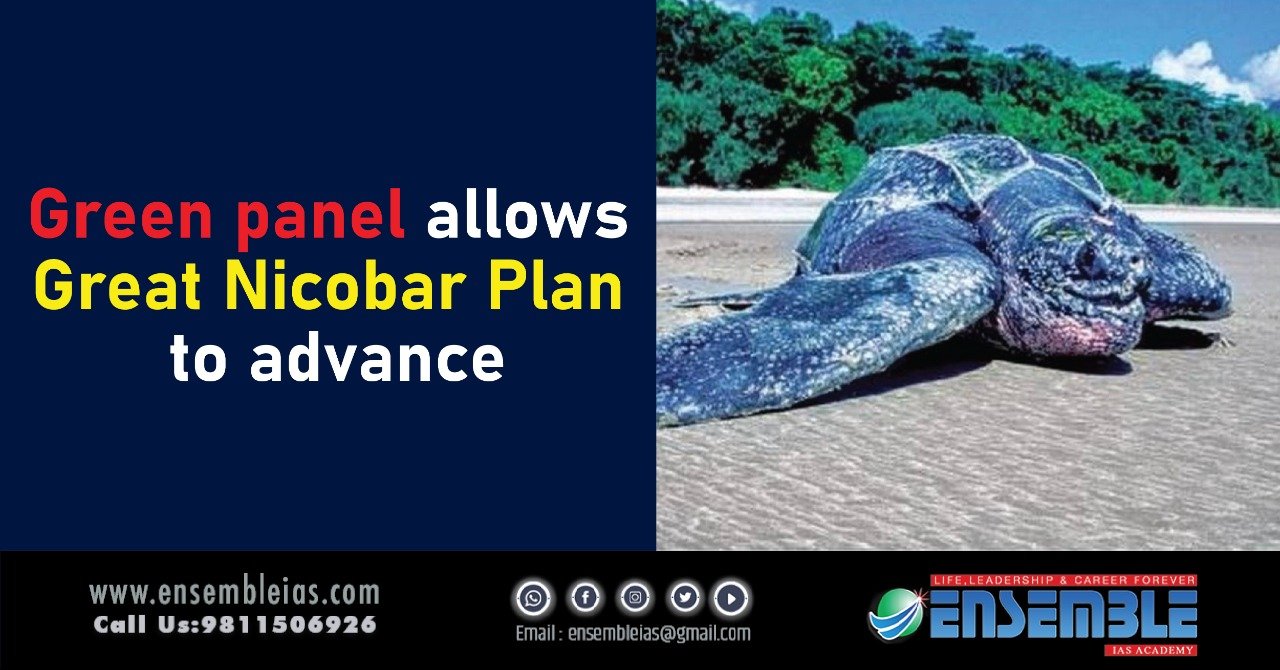Green panel allows Great Nicobar plan to advance:
The Environment Appraisal Committee (EAC) – Infrastructure I of the Ministry of Environment, Forest and Climate Change (MoEFCC) has flagged serious concerns about NITI Aayog’s ambitious project for Great Nicobar Island (‘NITI Aayog vision for Great Nicobar ignores tribal, ecological concerns’, The Hindu, March 21, 2021). The committee has, however, removed the first hurdle faced by the project. It has “recommended” it “for grant of terms of reference (TOR)” for Environmental Impact Assessment (EIA) studies, which in the first instance will include baseline studies over three months.
To buy our online courses: Click Here
Documents uploaded recently on the MoEFCC’s Parivesh portal show that the 15-member committee headed by marine biologist and former director, Bombay Natural History Society (BNHS), Deepak Apte, made the decision following two meetings held on March 17 and 18 and April 5 and 6. The EAC was responding to the 126 page ‘pre-feasibility’ report, ‘Holistic Development of Great Nicobar Island at Andaman and Nicobar Islands’, prepared for the NITI Aayog by the Gurugram-based consulting agency Aecom India Private Limited. The proposal includes an international container transshipment terminal, a greenfield international airport, a power plant and a township complex spread over 166 sq. km. (mainly pristine coastal systems and tropical forests), and is estimated to cost ₹75,000 crore.
Concerns on site
The committee’s concerns were both procedural and substantive. A discussion on the proposal in the March meeting was deferred because of delayed and incomplete submission of documents. The missing information included the minutes of the meeting note, details of the township to be developed over 149 sq. km., a note on seismic and tsunami hazards, freshwater requirement details (6.5 lakh people are envisaged to finally inhabit the island when the present population is only 8,500; the current total population of the entire island chain is less than 4.5 lakh), and details of the impact on the Giant Leatherback turtle.
The committee also noted that there were no details of the trees to be felled — a number that could run into millions since 130 sq. km. of the project area has some of the finest tropical forests in India. A point-wise response to concerns was submitted by the project proponent, the Andaman and Nicobar Island Integrated Development Corporation (ANIIDCO), on April 5, the very day the committee convened for its next meeting. Yet, the proposal was taken up for consideration and even recommended for grant of ToR to go ahead.
This, despite the fact that the committee raised a number of additional issues, including about Galathea Bay, the site of the port and the centrepiece of the NITI Aayog proposal. Galathea Bay is an iconic nesting site in India of the enigmatic Giant Leatherback, the world’s largest marine turtle — borne out by surveys done over three decades by the island’s Forest Department and research agencies like the Andaman and Nicobar Environment Team, Dakshin Foundation and the Indian Institute of Science (IISc) (‘Leatherback nesting sites could be overrun by Andamans projects’, The Hindu, February 15, 2021).
The committee noted that the site selection for the port had been done mainly on technical and financial criteria, ignoring the environmental aspects. It has now asked for “an independent study/ evaluation for the suitability of the proposed port site with specific focus on Leatherback Turtle, Nicobar Magapod (sic) and Dugong”.
Action points
This, in fact, is only one of over a 100 specific points of action listed out by the committee. They include, among others, the need for an independent assessment of terrestrial and marine biodiversity, a study on the impact of dredging, reclamation and port operations, including oil spills (to be carried out by nationally recognised institutions such as the Wildlife Institute of India, IISc or the Salim Ali Centre for Ornithology and Natural History), the need for studies of alternative sites for the port with a focus on environmental and ecological impact, especially on turtles, analysis of risk-handling capabilities, a seismic and tsunami hazard map, a disaster management plan, details of labour, labour camps and their requirements, an assessment of the cumulative impact, and a hydro-geological study to assess impact on round and surface water regimes.
Corporate policy
The committee has also asked for details of the corporate environment policy of the implementing agency — whether the company has an environmental policy, a prescribed standard operating procedure to deal with environmental and forest violations, and a compliance management system.
ANIIDCO, the Port Blair project proponent, is a government undertaking involved in activities such as tourism, trading (iron and steel, milk, petroleum products, and liquor) and infrastructure development for tourism and fisheries. Its annual turnover for 2018-19 was ₹379 crore, and handling a mega infrastructure project estimated to cost ₹75,000 crore appears way beyond its capacity.
AECOM’s pre-feasibility report has proposed 2022-23 for the commencement of work on the site. “How is that possible,” asks an island expert, requesting anonymity. “One year is simply not enough if the government and project proponents follow the EAC’s recommendations in letter and spirit. And how can extensive baseline studies be carried out in just three months?”
Ecological surveys in the last few years have reported a number of new species, many restricted to just the Galathea region. These include the critically endangered Nicobar shrew, the Great Nicobar crake, the Nicobar frog, the Nicobar cat snake, a new skink (Lipinia sp), a new lizard (Dibamus sp,) and a snake of the Lycodon sp that is yet to be described.
Also Read: This CEO is on a mission to create global citizens
“None of these are even mentioned in AECOM’s pre-feasibility report or the EAC’s observations,” he notes. “We don’t even fully know what exists here, leave alone understanding the many fragile inter-linkages of the Great Nicobar’s complex systems.”
(Green panel allows Great Nicobar plan to advance:)





